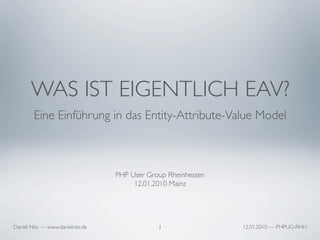
Was ist eigentlich EAV?
- 1. WAS IST EIGENTLICH EAV? Eine Einführung in das Entity-Attribute-Value Model PHP User Group Rheinhessen 12.01.2010 Mainz Daniel Nitz — www.danielnitz.de 1 12.01.2010 — PHPUG-RHH
- 2. AGENDA 1. Definition 4. Nachteile 2. Anwendungsbeispiel 5. In der Praxis 3. Vorteile 6. Fazit Daniel Nitz — www.danielnitz.de 2 12.01.2010 — PHPUG-RHH
- 3. DEFINITION Daniel Nitz — www.danielnitz.de 3 12.01.2010 — PHPUG-RHH
- 4. DEFINITION Entity-Attribute-Value Model, auch bekannt als Object- Attribute-Value Model und Open Schema ist ein Datenmodell, welches dann zum Einsatz kommt, wenn die Anzahl der Attribute (Eigenschaften, Parameter) zur Beschreibung einer Sache (Entität oder Objekt) im Vorfeld nicht vorhersehbar sind. Daniel Nitz — www.danielnitz.de 4 12.01.2010 — PHPUG-RHH
- 5. DEFINITION EAV ist ein Datenmodell für den Fall, dass die Anzahl der Attribute eines Objektes nicht vorhersehbar sind. Daniel Nitz — www.danielnitz.de 5 12.01.2010 — PHPUG-RHH
- 6. DEFINITION Entity: Repräsentiert einen Datensatz, z.B. eine Produkt. Attribute: Stellt eine Eigenschaft dar, z.B. Größe, Farbe etc. Value: Beinhaltet den Eigenschaftswert, z.B. XL, blau etc. Daniel Nitz — www.danielnitz.de 6 12.01.2010 — PHPUG-RHH
- 7. DEFINITION 1:n 1:1 Entity Attribute Value 3 Tabellen verknüpft mittels Foreign Keys. Daniel Nitz — www.danielnitz.de 7 12.01.2010 — PHPUG-RHH
- 8. HÄ? Daniel Nitz — www.danielnitz.de 8 12.01.2010 — PHPUG-RHH
- 9. ANWENDUNGSBEISPIEL Unterschied EAV im Vergleich zum relationalen Design Daniel Nitz — www.danielnitz.de 9 12.01.2010 — PHPUG-RHH
- 10. ANWENDUNGSBEISPIEL ‣ Eine Person wird anhand einer eindeutigen Nummer identifiziert ‣ Eine Person hat einen Vornamen ‣ Eine Person hat einen Nachnamen ‣ Ein Person hat eine beliebige Anzahl von zusätzlichen Informationen (Alter, Gewicht, Größe etc.) Daniel Nitz — www.danielnitz.de 10 12.01.2010 — PHPUG-RHH
- 11. RELATIONALES DESIGN Person Data person_id 1:1 person_id first_name age last_name weight height Daniel Nitz — www.danielnitz.de 11 12.01.2010 — PHPUG-RHH
- 12. EAV DESIGN Entity Attribute Value 1:1 entity_id 1:n attribute_id attribute_id entity_id value attribute_name Daniel Nitz — www.danielnitz.de 12 12.01.2010 — PHPUG-RHH
- 13. STORY Relationales Design: Die Person mit der Nummer 1 hat das Alter 30, hat ein Gewicht von 80, hat eine Größe von 180. EAV Design: Die Person mit der Nummer 1 hat das Attribut Alter mit dem Wert 30. Die Person mit der Nummer 1 hat das Attribut Gewicht mit dem Wert 80. Die Person mit der Nummer 1 hat das Attribut Größe mit dem Wert 180. Daniel Nitz — www.danielnitz.de 13 12.01.2010 — PHPUG-RHH
- 14. DESIGN PROBLEME ‣ keine Datentypen ‣ keine definierten Spalten-/Attributsets ‣ Redundanz von Attributen ‣ keine Integrität Daniel Nitz — www.danielnitz.de 14 12.01.2010 — PHPUG-RHH
- 15. EAV DESIGN Entity Attribute Value 1:1 entity_id 1:n attribute_id attribute_id entity_id value_id attribute_name 1:1 1:1 Value Int Value ... value_id value_id value value Daniel Nitz — www.danielnitz.de 15 12.01.2010 — PHPUG-RHH
- 16. EAV DESIGN Entity Entity_Attribute Value 1:1 entity_id 1:n ea_id ea_id entity_id value_id attribute_id as_id 1:1 1:1 Attribute Set Attribute Value Int Value ... as_id attribute_id value_id value_id as_name attribute_name value value Daniel Nitz — www.danielnitz.de 16 12.01.2010 — PHPUG-RHH
- 17. DESIGN PROBLEME ‣ verschiedene Datentypen ‣ definierte Spalten-/Attributsets ‣ keine Redundanz von Attributen ‣ Integrität gewahrt Daniel Nitz — www.danielnitz.de 17 12.01.2010 — PHPUG-RHH
- 18. VORTEILE Daniel Nitz — www.danielnitz.de 18 12.01.2010 — PHPUG-RHH
- 19. VORTEILE ‣ Hohe Flexibilität in der Gestaltung von Objektstrukturen ‣ Kein DBA zur Änderung der Schemata nötig ‣ Keine zusätzliche Programmierung bei Änderung der Schemata nötig Daniel Nitz — www.danielnitz.de 19 12.01.2010 — PHPUG-RHH
- 20. NACHTEILE Daniel Nitz — www.danielnitz.de 20 12.01.2010 — PHPUG-RHH
- 21. NACHTEILE ‣ Hohe Systemlast durch komplizierte SQL Queries ‣ Komplexe Programmierung von SQL Statements ‣ Verlust von DBMS-spezifischen Funktionalitäten ‣ Verlagerung von DBMS-Funktionen in die Anwendungslogik Daniel Nitz — www.danielnitz.de 21 12.01.2010 — PHPUG-RHH
- 22. IN DER PRAXIS Daniel Nitz — www.danielnitz.de 22 12.01.2010 — PHPUG-RHH
- 23. EAV MODEL LIBRARY Dmg_Db_Eav: ‣ EAV Model Implementierung für das Zend Framework ‣ Auf Basis von Zend_Db und Zend_Db_Table ‣ Nutzung von Zend_Cache Daniel Nitz — www.danielnitz.de 23 12.01.2010 — PHPUG-RHH
- 24. CODE BEISPIEL $options = new Dmg_Db_Eav_Config($array); // Person implements Dmg_Db_Eav_Abstract $personModel = new Person($options); $persons = $personModel->addAttributeFilter('age', 30) ->addAttributeFilter('name', 'daniel') ->addFilter('active', 1) ->addLimit(10) ->load(); Daniel Nitz — www.danielnitz.de 24 12.01.2010 — PHPUG-RHH
- 25. CODE BEISPIEL foreach ($persons as $person) { $attributes = $person->getAttributes(); foreach ($attributes as $attribute) { if (!$attribute->hasOptions()) { echo $attribute->getName() . ': ' . $attribute->getValue(); } else { foreach ($attribute->getOptions() as $option) { echo $option->getName() . ': ' . $option->getValue(); } } } } Daniel Nitz — www.danielnitz.de 25 12.01.2010 — PHPUG-RHH
- 26. PERFORMANCE # Time Query 1 0.223762989044 connect SELECT `e`.*, `v`.*, `a`.*, `as`.*, `g`.*, `ga`.* FROM `eav_entity` AS `e` INNER JOIN `eav_value` AS `v` ON e.entity_id = v.entity_id INNER JOIN `eav_attribute` AS `a` ON v.attribute_id = a.attribute_id INNER JOIN `eav_attribute_set` AS `as` ON e.attribute_set_id = 2 0.42297410965 as.attribute_set_id INNER JOIN `eav_attribute_group` AS `g` ON g.attribute_set_id = as.attribute_set_id INNER JOIN `eav_attribute_group_attribute` AS `ga` ON a.attribute_id = ga.attribute_id WHERE (e.entity_id = 1) 3 0.0507569313049 DESCRIBE `eav_entity` SELECT eav_value_varchar.*, CONCAT('varchar') AS type FROM eav_value_varchar WHERE value_id IN (1, 3) UNION SELECT 4 0.757645130157 eav_value_int.*, CONCAT('int') AS type FROM eav_value_int WHERE value_id IN (2) UNION SELECT eav_value_text.*, CONCAT('text') AS type FROM eav_value_text WHERE value_id IN (4) ... ... ... Query Zeit beim Laden eines EAV Objektes ohne Cache mit 4 Attributen, eines davon hat 6 Attributoptionen: 1.949 sec Nach dem Caching: 0.079 sec Daniel Nitz — www.danielnitz.de 26 12.01.2010 — PHPUG-RHH
- 27. FAZIT Daniel Nitz — www.danielnitz.de 27 12.01.2010 — PHPUG-RHH
- 28. FAZIT ‣ EAV bietet gute Möglichkeiten eine Anwendung in der Datenschicht flexibel zu halten. ‣ Es gibt jedoch nur wenige Anwendungsfälle, in denen eine EAV Implementierung wirklich sinnvoll ist. ‣ Ein relationales Design sollte dem EAV, wenn möglich, vorgezogen werden. Daniel Nitz — www.danielnitz.de 28 12.01.2010 — PHPUG-RHH
- 29. VIELEN DANK! Daniel Nitz [ zend certified engineer ] daniel@danielnitz.de twitter.com/danielnitz Daniel Nitz — www.danielnitz.de 29 12.01.2010 — PHPUG-RHH